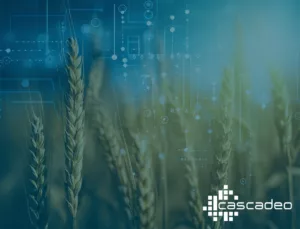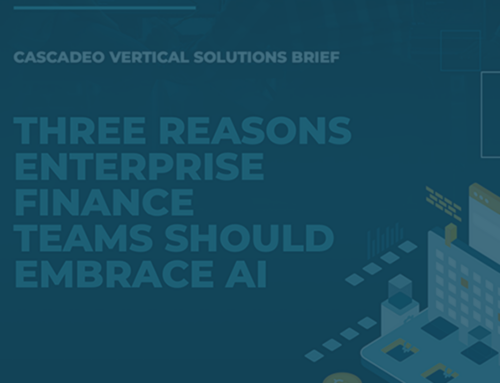
Now is the time to prioritize responsible, thoughtful implementation of AI in agriculture to create a more stable and environmentally sustainable food system. Learn how generative AI can be used to support a new age of farming in this guest post by Cascadeo CTO Jared Reimer.
Generative AI can support sustainable, efficient farming
 Imagine an organic farm where AI-powered robots roam the fields, their sensors analyzing soil moisture, crop growth and nutrient levels in real time. Equipped with high-precision lasers, LIDAR, and cameras, these robots can precisely target and eliminate weeds, reducing the need for harmful chemicals and reducing the environmental footprint (and cost) of agriculture. This is not science fiction but a tangible reality of how AI can enhance sustainable farming practices, conserving resources while improving crop health and yield.
Imagine an organic farm where AI-powered robots roam the fields, their sensors analyzing soil moisture, crop growth and nutrient levels in real time. Equipped with high-precision lasers, LIDAR, and cameras, these robots can precisely target and eliminate weeds, reducing the need for harmful chemicals and reducing the environmental footprint (and cost) of agriculture. This is not science fiction but a tangible reality of how AI can enhance sustainable farming practices, conserving resources while improving crop health and yield.
New Opportunties
In fact, more than 200 AI-agriculture startups have emerged in recent years in the U.S., banking on AI capabilities to manage data in ways that foster sustainability and efficiency in an industry that has struggled to stabilize profits and cope with price fluctuations for decades. Several factors are currently slowing widespread adoption of these tools and scaling of some AI-ag offerings, including reluctance on the part of farmers to trust new technologies, attempts at “vendor lock-in” by some equipment manufacturers, a shifting regulatory landscape in an industry that’s already among the most heavily regulated in the world, and the expense of building the strong base of agricultural data required to provide value. Considering climate change, a growing global population, and the finite nature of our planet’s natural resources, investing in both the tools and the market for AI-assisted farming will become a priority as awareness and availability of the technology increases.
Better Weather
AI’s predictive capabilities are revolutionizing weather forecasting, offering farmers granular insights into future climatic conditions. By analyzing vast datasets from satellites and weather stations, AI models predict weather patterns with remarkable accuracy, enabling farmers to make informed decisions about planting, irrigation, and harvesting. This foresight is crucial in mitigating the impact of climate variability on crop yields and ensuring food security in an unpredictable world. It reduces waste, toil, and weather-related crop loss scenarios.
Crop Genetics
At the genetic level, AI is unlocking the potential of crops in ways previously unimaginable. Through machine learning algorithms, scientists can analyze genetic data from plants to identify traits that enhance yield, nutritional value, and resistance to pests and diseases. This AI-driven approach accelerates the breeding of new crop varieties, tailored to the specific needs of different regions and climates, heralding a future of abundant, resilient food sources and further reducing the need for pesticides, herbicides, and fertilizers.
Labor-Free Farming
The pinnacle of AI’s integration into agriculture is the prospect of fully mechanized farms, where physical human labor is reduced to a minimum or even zero. Autonomous tractors will plow fields, drones will monitor crop health from the sky, and robotic harvesters will gather produce, all orchestrated by sophisticated AI systems that optimize every aspect of farm management. This vision promises not only to dramatically increase efficiency and productivity but also to reshape rural economies and labor markets. It frees humans from toil while contributing to the eradication of world hunger. The automation of manual labor will also reduce the dependency on migrant farm workers, many of whom live in poverty and in temporary camps which are far below what we would consider to be acceptable housing.
Data Sharing and Supply Chain Optimization
AI’s influence extends beyond direct farming activities. Supply chain optimization algorithms reduce waste and improve the efficiency of food distribution, ensuring that produce reaches markets in the freshest possible state. AI-driven platforms can facilitate data sharing among farmers, researchers, and policymakers, fostering a collaborative ecosystem that leverages collective intelligence to tackle global food challenges.
Policy Support
With widespread adoption and support from policymakers, AI can empower us to produce food more sustainably, efficiently, and resiliently than ever before. Senators on both sides of the aisle are considering ways to prioritize AI implementation in the farm bill, and are emphasizing “a light touch” in regulation, both of which may help. Enabling factors like expanding rural broadband access to help farmers take advantages of advanced data tools are also on the table. Considering the long history of the farm bill and its profound impact on our food system, it presents a powerful opportunity to advocate for AI adoption in the U.S.
Embracing the Future
As we embrace the AI future, let us do so with a commitment to the greater good, sustainability, and the collective well-being of our planet and its inhabitants. Agriculture is as old as human civilization itself, being the key enabler of permanent settlements and advanced societies. Embracing innovation has helped farmers thrive in seemingly impossible conditions brought on by increasing demand and changing climates throughout history. Now is the time to prioritize responsible, thoughtful implementation of AI in agriculture to create a more stable and environmentally sustainable food system.




